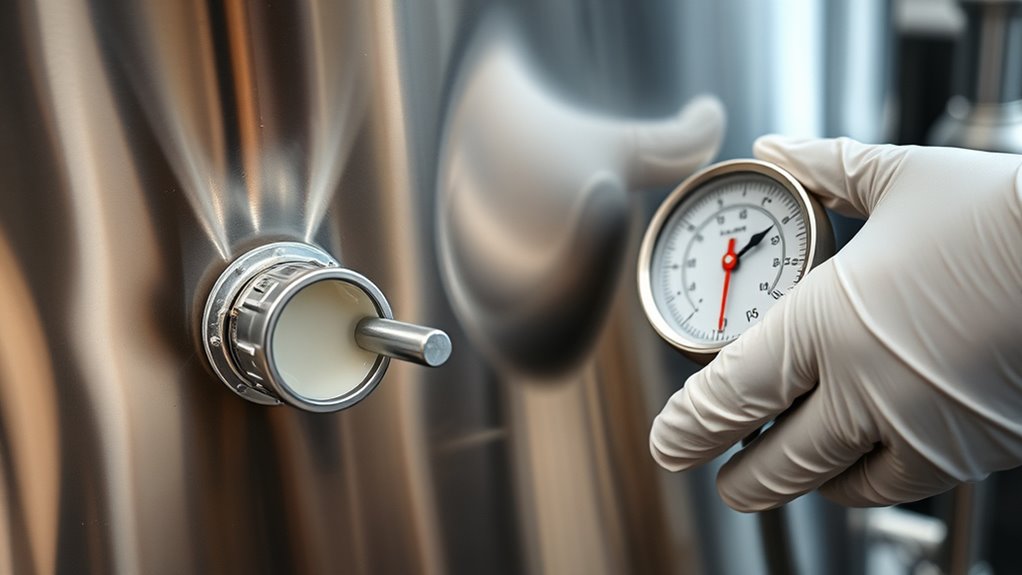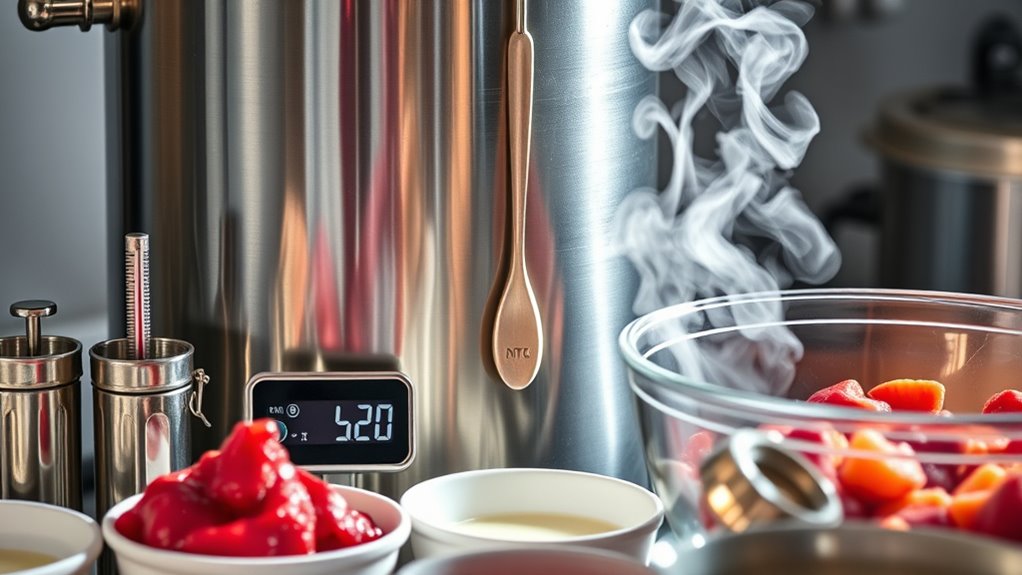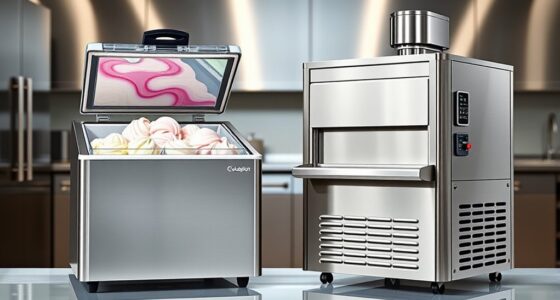Even seasoned gelato makers often make common pasteurization mistakes, like overlooking raw milk quality or neglecting equipment sanitation. You might also mishandle temperature controls or skip thorough testing, risking contamination. These errors can compromise safety and result in poor product quality. Staying vigilant about sourcing, cleaning, and monitoring helps prevent these issues. Keep going to uncover key tips that can keep your process safe and your gelato excellent.
Key Takeaways
- Improper raw milk sourcing and inadequate testing can introduce pathogens that pasteurization cannot eliminate.
- Failing to thoroughly clean and sanitize equipment, especially hard-to-reach areas, increases contamination risk.
- Inaccurate temperature control during pasteurization may leave bacteria alive, compromising safety.
- Overlooking raw material quality checks leads to compromised milk affecting final product safety.
- Inconsistent hygiene practices and poor drying of equipment promote bacterial growth and cross-contamination.

Pasteurization is a vital process for ensuring food safety, but it’s not foolproof. Even seasoned gelato makers can overlook critical details that compromise the safety and quality of their products. One common mistake that can lead to issues is overlooking milk contamination. If milk isn’t sourced properly or if it gets contaminated during handling, pasteurization alone can’t fix those problems. Milk contamination can occur at any point from farm to processing, so it’s essential to verify that your suppliers follow strict hygiene standards. Regular testing of raw milk for pathogens and impurities can help catch issues early. Additionally, always inspect milk upon arrival, checking for off-odor, discoloration, or unusual textures, which might indicate contamination. Remember, the best pasteurization process won’t save you if the raw material is compromised from the start.
Another mistake often made by even experienced gelato makers relates to equipment sanitation. Proper equipment sanitation isn’t just about cleanliness; it’s about preventing cross-contamination and residual buildup that can harbor bacteria. Failing to thoroughly clean and sanitize all equipment—such as mixing bowls, thermometers, and pasteurization tanks—can introduce harmful microbes into your product. These microbes can survive if cleaning isn’t effective, especially if the equipment has crevices or hard-to-reach spots. Using the right cleaning agents and following a strict sanitation protocol is essential. Remember to rinse thoroughly after cleaning to remove any soap residues that could interfere with pasteurization or spoil the product. Once equipment is sanitized, ensure it’s completely dry before use, as moisture can promote bacterial growth. Additionally, monitoring hygienic practices throughout the process is crucial for maintaining product safety.
Many makers also underestimate the importance of maintaining proper temperatures during pasteurization and storage. Even if you have sanitized equipment and high-quality raw milk, failing to monitor temperature accurately can lead to incomplete pasteurization. Undercooking or uneven heating might leave some bacteria alive, risking contamination. Likewise, improper storage temperatures afterward can allow bacteria to multiply rapidly. Using calibrated thermometers and adhering strictly to recommended temperature ranges is key to avoiding these pitfalls. It’s easy to think that once the milk is pasteurized, the risk is gone, but contamination can reoccur if storage conditions are neglected.
Frequently Asked Questions
How Can I Tell if My Pasteurization Process Was Successful?
You can tell if your pasteurization process was successful by checking for temperature consistency throughout the process, ensuring the mixture reached the correct temperature for the required time. This helps verify microbial safety by killing harmful bacteria effectively. Use a reliable thermometer, monitor the temperature regularly, and record your data. If the process maintains proper temperature and timing, it’s a good sign your pasteurization was successful and your gelato is safe to serve.
What Are the Best Tools to Monitor Pasteurization Temperature Accurately?
Imagine a precise thermometer nestled in your gelato mix, its needle steady as you watch the temperature rise. To monitor pasteurization accurately, use well-calibrated thermometers, ensuring their readings stay true. Incorporate temperature data logging tools that record every degree, giving you a clear picture of your process. Regular thermometer calibration keeps your measurements reliable, helping you avoid mishaps and achieve perfect, safe gelato every time.
How Does Pasteurization Affect Gelato Flavor and Texture?
Pasteurization plays a vital role in gelato making by influencing flavor development and texture consistency. When done correctly, it helps eliminate bacteria without compromising quality. If you overheat or underheat, it can dull the flavors and cause texture issues like iciness or separation. Proper pasteurization guarantees your gelato has a smooth, rich flavor and a creamy, stable texture, making it more enjoyable for everyone.
Can I Reuse Pasteurized Mixtures Without Compromising Safety?
You can reuse pasteurized mixtures, but you need to prioritize storage safety to prevent contamination risks. Always cool the mixture quickly and store it in a sanitized, airtight container in the fridge. Reusing it too long increases contamination risks and can compromise safety. Remember, proper handling and timely use are key to maintaining both safety and quality. If in doubt, it’s best to make fresh batches to avoid any health issues.
What Are Common Signs of Under- or Over-Pasteurization?
You might worry about missing signs of under- or over-pasteurization, but recognizing them is simpler than you think. Look for temperature inconsistencies, which can cause uneven pasteurization, and flavor degradation, indicating overheating. If the mixture tastes off or has unusual textures, it’s a sign to check your process. Staying attentive helps prevent these issues, ensuring safe, delicious gelato every time.
Conclusion
Think of pasteurization as tending a delicate garden; even seasoned gardeners can overlook a weed or forget to water. Each step, like nurturing your plants, requires attention to detail. When you slip up, pests or droughts threaten your harvest. But with vigilance and care, your gelato garden blooms beautifully. Keep refining your craft, and your creations will flourish, delighting every palate. Remember, mastery isn’t just about knowing the rules—it’s about tending your craft with mindful persistence.









